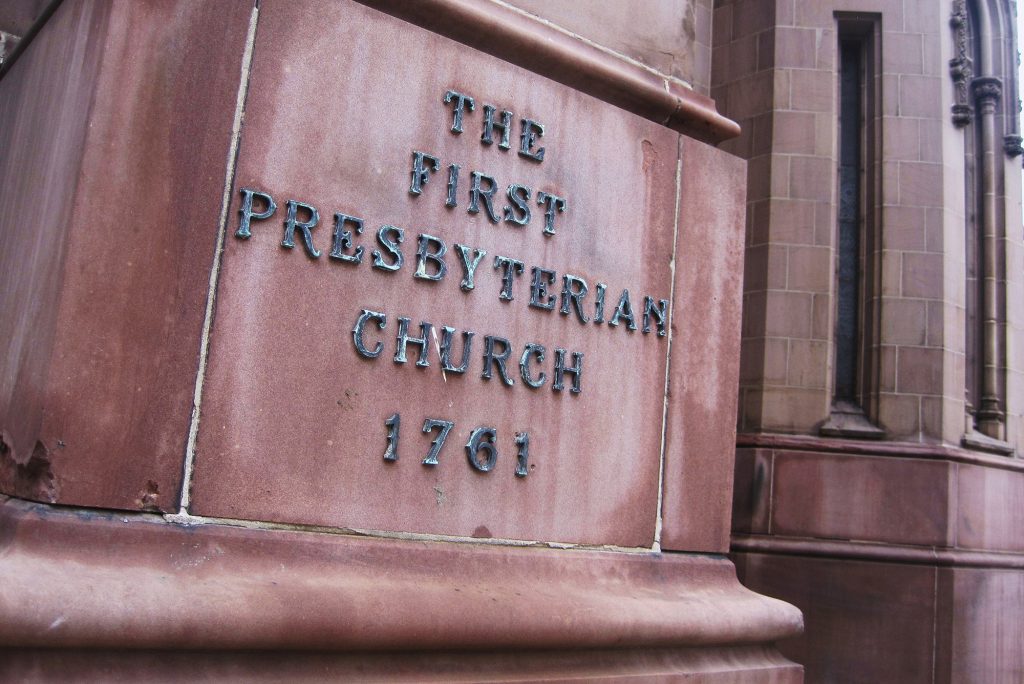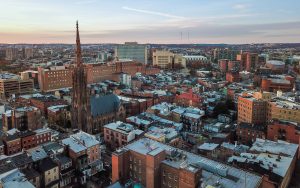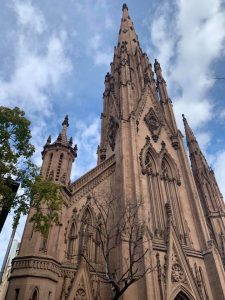History
ORIGINS
The First Presbyterian Church was founded in 1761 by several Scots-Irish families who came to Baltimore Towne from the Pennsylvania frontier to escape the terrors of the French and Indian War. They were merchants, physicians, farmers, and builders. Known as “Dissenters” because they opposed the Church of England as the established state church, they supported the cause of independence during the American Revolution and advocated the separation of Church and state set forth in the First Amendment of the U.S. Constitution.
Our founding Minister, The Rev. Dr. Patrick Allison (1740 – 1802) was a Chaplain to the Continental Congress and was a personal friend of George Washington. After conducting worship in private homes clustered around the Inner Harbor, the congregation moved to a log church in 1763, to a brick church in 1765, and later to an enormous church with two steeples and a columned portico in 1790. This "two-steepled" church was located at Fayette and Guilford, east of where the Clarence Mitchell courthouse stands today. It was one of the largest meeting places in the city, used for sacred and secular purposes.
PRESENT LOCATION
In 1836 John Chester Backus was called as minister. He was well-educated and wealthy, as evidenced by the large, privately owned house he built next to the church - now known as Backus House. He moved the congregation from the quickly commercializing harbor area to our current church which opened October 1, 1859 at the corner of Park Avenue and Madison Street. The magnificent Gothic Revival edifice in which we worship was designed by the American architect Norris G. Starkweather. In 1875, the 273 foot tall steeple was added, which remains the tallest steeple in the City of Baltimore.
Baltimore was one of the largest cities in the nation. Factories and insurance companies, cultural institutions and banks sprouted up like dandelions. Shipping and the railroad made Baltimore famous. Our sanctuary was not just a place to worship but a meeting place where many immigrants and established Americans came to give thanks for their good fortune in Baltimore. The pews have numbers on them because the families of the church rented their pews a common practice. Elizabeth (Betsy) Patterson, sister in law of Napoleon Bonaparte, sat in pew 88 which was removed with several others to create more space. The urns at the back of the sanctuary memorialize our first pastor Patrick Allison and Dr. John Backus who was the pastor during the construction of the current church building.
GROWTH (Why the name First & Franklin?)
Meanwhile, our church was sending forth colonies of members to found new congregations throughout the city. In this effort, The Franklin Street Presbyterian Church was founded in 1844. Its brick and Gothic structure still stands on the corner of Cathedral and Franklin Street. In 1973, the two historic congregations reunited to form The First & Franklin Street Presbyterian Church and, in 2012 the congregation voted change it to the simpler First & Franklin Presbyterian Church.

FIRST & FRANKLIN TODAY
Besides Sunday Worship, we use this space for theater, concerts, guest speakers, and art shows in our Spire Series events featuring local and internationally famous musical artists, amazing thousands of people over the years. We want this space to belong to all Baltimoreans and have it humming with activity every day. We have a fantastic choir made up of passionate, talented congregants with paid section leaders from Peabody Conservatory
PURPLE RIBBON PROJECT
During the Iraq conflict, the church read the names in worship and hung a yellow ribbon outside on Park Avenue for every two service members killed. When that conflict officially ended, First & Franklin turned our attention to gun violence in our city. We work for an end to this epidemic by engaging community leaders, reading their names, praying for their families, and hanging out a purple ribbon on our Park Avenue wall.
LGBTQ+ (read more about our LGBTQ+ history)
Beginning in the early 1980’s, AIDS killed thousands in Baltimore and many churches rejected members or visitors who let it be known they were HIV positive including refusing to perform funerals. The elders of this church decided that they would welcome all people, especially people who were excluded for their sexual orientation/identity or HIV status. In 1980, the Session, our spiritual governing body of Elders, adopted “The More Light Statement”, by which we aligned ourselves with other congregations in search of a better understanding of issues surrounding gay and lesbian rights. We are a welcoming Church to all who would be faithful Christians, regardless of sexual orientation and are members of both the More Light Presbyterians and the Covenant Network of Presbyterians. In 1983 we hosted Baltimore’s first public forum on the AIDS crisis. In 2011, the denomination welcomed LGBTQ+ as elders, deacons and ministers of word and sacrament and in 2015 hosted some of Baltimore’s first legal LGBTQ+ weddings even though we had performed weddings for same-sex couples since the 1970s.








